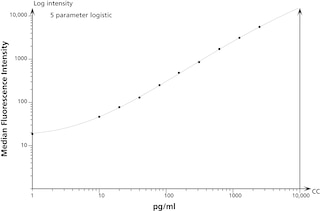Old Browser
This page has been recently translated and is available in French now.
Looks like you're visiting us from {countryName}.
Would you like to stay on the current country site or be switched to your country?



Functional studies of TC11-18H10 mAb by neutralization of mouse IL-17A bioactivity. Recombinant mouse IL-17A (2 ng/well) was pre-incubated with various amounts of TC11-18H10 mAb or medium as a control in a 96-well plate for 1 hour at 37°C. Following the incubation, NIH-3T3 cells were added at 5x10^4 cells per well and incubated at 37°C. After 24 hours of incubation, the supernatant was harvested and the concentration of IL-6 was quantified using BD™ Cytometric Bead Array Mouse IL-6 Flex Set (Cat. No. 558301).

BD Pharmingen™ Purified NA/LE Rat Anti-Mouse IL-17A
Regulatory Status Legend
Any use of products other than the permitted use without the express written authorization of Becton, Dickinson and Company is strictly prohibited.
Preparation And Storage
Recommended Assay Procedures
ELISA: Purified TC11-18H10 antibody (Cat. No. 560268) can be useful as a capture antibody for sandwich ELISA measuring mouse IL-17A protein levels. Purified TC11-18H10 antibody can be paired with biotinylated TC11-8H4 (Cat. No. 555067) as the detector antibody, with recombinant mouse IL-17A protein as the standard. Investigators are encouraged to titrate purified TC11-18H10 from 2.0 µg/mL - 0.5 µg/mL for optimal concentration determination for ELISA capture. To obtain linear standard curves, doubling dilutions of recombinant mouse IL-17A are suggested from 2,000 - 15 pg/mL.
Product Notices
- Since applications vary, each investigator should titrate the reagent to obtain optimal results.
- An isotype control should be used at the same concentration as the antibody of interest.
- Please refer to www.bdbiosciences.com/us/s/resources for technical protocols.
Companion Products



The TC11-18H10 monoclonal antibody specifically binds to recombinant and natural mouse IL-17A proteins. IL-17A, also known as CTLA-8, is a T cell-derived cytokine that promotes inflammatory responses. Mouse IL-17A is a proinflammatory cytokine that can induce the release of IL-6 by mouse stromal cells. It has been shown to support the growth of hemopoietic progenitors in vitro; it can also stimulate granulopoiesis in vivo. The TC11-18H10 antibody has been reported to neutralize IL-17A activity. Recent studies have shown that IL-17A is produced by a unique subset of Th17 cells that develop along a pathway distinct from the Th1- and Th2- cell differentiation pathways. The mouse IL-17A cDNA was isolated from a cDNA library generated from TCRαβ+CD4-CD8- thymocytes.
Development References (4)
-
Kennedy J, Rossi DL, Zurawski SM, et al. Mouse IL-17: a cytokine preferentially expressed by alpha beta TCR + CD4-CD8-T cells. J Interferon Cytokine Res. 1996; 16(8):611-617. (Biology). View Reference
-
Prussin C, Metcalfe DD. Detection of intracytoplasmic cytokine using flow cytometry and directly conjugated anti-cytokine antibodies. J Immunol Methods. 1995; 188(1):117-128. (Biology). View Reference
-
Schwarzenberger P, La Russa V, Miller A, et al. IL-17 stimulates granulopoiesis in mice: use of an alternate, novel gene therapy-derived method for in vivo evaluation of cytokines. J Immunol. 1998; 161(11):6383-6389. (Biology). View Reference
-
Yen D, Cheung J, Scheerens H et al. IL-23 is essential for T cell–mediated colitis and promotes inflammation via IL-17 and IL-6. J Clin Invest. 2006; 116(5):1310-1316. (Methodology: Neutralization). View Reference
Please refer to Support Documents for Quality Certificates
Global - Refer to manufacturer's instructions for use and related User Manuals and Technical data sheets before using this products as described
Comparisons, where applicable, are made against older BD Technology, manual methods or are general performance claims. Comparisons are not made against non-BD technologies, unless otherwise noted.
For Research Use Only. Not for use in diagnostic or therapeutic procedures.
Report a Site Issue
This form is intended to help us improve our website experience. For other support, please visit our Contact Us page.